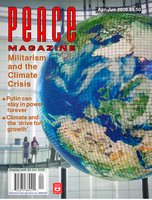
Peace Magazine April-June 2020, page 28. Some rights reserved.
Search for other articles by John Bacher here
Robert Max Holmes, Susan Natali, and John Schade, with photography by Chris Linder. Published by Braided River/Woods Hole Research Center, 2019.
The Big Thaw is an overdue book, spectacularly photographed; a book which finally draws attention to the reality of the race to save the world. The race is to rescue permafrost from melting away and in so doing eliminate a noxious mix of vapors which would trigger catastrophic disruption to the world’s climate.
The book is full of gripping images which show the reality of permafrost retreat. Lopsided trees, scarred landscapes and even new lakes created as a consequence of permafrost melt.
Many of the horrors presented would have been worse if not for campaigns of environmentalists to protect Arctic ecosystems. One photograph shows the Yukon River delta on Alaska’s Bering Sea coast. A disturbing image, akin to Swiss cheese, reveals the scale of destruction. You may still be able to see a mosaic of green here and there — interspersed with black patches from recent burns, however.
The authors explain how in 2015, a drier summer — triggered by climate change — ignited a massive shrub fire in the Yukon delta, incinerating 725 square kilometres. This is substantially greater than the 475 km^2^ impacted by fire over the previous 74 years. In addition, the burnt areas become more vulnerable to permafrost melt.
What makes the threats to the Yukon Delta so worrisome is that it is one of the best-protected landscapes in the world. Most of the area is under wilderness protection, free of roads and thus saving the permafrost from being cut up by all-terrain vehicles. There are no dams on the Yukon River, making the delta the beneficiary of flooding, which in less carefully managed watersheds has been disrupted. Without such past conservation efforts, the Arctic burning described in The Big Thaw would be far worse.
Given the threats to Arctic ecosystems, the authors warn that it is not enough just to safeguard what is there. They are strong supporters of the Arctic vision of the father-and-son team of Russian ecologists, Sergey and Nikita Zimov, managers of the 145 km2 Pleistocene Park in northeastern Siberia.
In Pleistocene Park, the Zimovs hope to recreate the rich grassland-dominated Mammoth Steppe, that vanished with the Pleistocene extinctions of 8,000 years ago. Restoring this more species-rich environment, the authors agree, is a practical way to halt the catastrophic permafrost melt hitting fragile landscapes dominated by moss and willows.
While genetic modifications for mammoth-like grazers are, at best, a decade in the future, European bison, yaks, sheep and musk oxen have already been introduced.
For a book that looks back in time for lessons in ecological restoration it is appropriate that The Big Thaw has an epilogue by Theodore Roosevelt IV, great-grandson and namesake of the US president and naturalist. The younger Roosevelt appropriately gives thanks to the authors, noting: “We owe the scientists from the Woods Hole Research Center and those with whom they collaborate an immense debt of gratitude. Their work provides us with essential information we need about greenhouse gases being emitted from the permafrost belt in order to create successful policies to meet the climate change challenge.”
Reviewed by John Bacher, a St Catherines-based writer and researcher.

Peace Magazine April-June 2020, page 28. Some rights reserved.
Search for other articles by John Bacher here